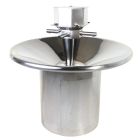The Pros & Cons of Unisex Washrooms

Unisex washrooms can be met with some trepidation from business owners and site managers, but also end-users as well. However, the benefits often outweigh the negatives and once in situ, it can actually be more advantageous on many levels.
A washroom for all
One of the great things about same-sex washrooms is that they are completely inclusive and can work to tackle transgender issues in all commercial environments. Unisex washrooms also mean parents of older children can accompany them to keep an eye on them much more easily.
8 Things we learned from new Single-Sex Toilet Guidelines
It will become compulsory to provide single-sex toilets in all New Restaurants and Offices under new laws that take affect later this year.
Building Regulations will be amended later in 2024, Read the Article on new Single-Sex Toilet Guidelines eight things we learned
Easy to monitor, clean and maintain
Unisex washrooms are much easier for staff to monitor and maintain, particularly in educational environments. Often the cubicles may still be divided between male and female, but with the open-plan wash area, it means faculty members can patrol the washroom more freely, regardless of their sex. We have also seen that unisex washrooms tend to be kept in a much cleaner condition, raising personal hygiene levels across all users.


They can tackle bullying
Most unisex washrooms either have a clear glass entry door or sometimes no door at all. This open-plan design means the washroom is no longer a secluded, hidden away area where bullying can thrive. Instead, they become busier, more visible communal spaces, which has been shown to reduce the risk of bullying.
Difficult for extremely high traffic environments
In extremely high traffic environments such as train stations, services, and shopping centres, unisex washrooms can be a little trickier to implement. Male urinals often throw up the main concern as in a same-sex washroom they need to be concealed within a cubicle. With the frequent, fast nature of a busy urinal, the cubicle doors can slow down user flow, which can create long queues at peak times.


Battling with tradition
Planning to create a unisex washroom can throw up some concerns in both corporate office environments, as well as schools where parents may need the benefits explaining. Some key points to remember is that cubicles are most often full height, meaning they span from floor to ceiling with no gaps. This creates a totally private enclosure. Urinals are usually not included, or when they are, they're concealed in their own private cubicle. Hygiene and cleanliness are generally raised across the washroom, and due to the open-plan, communal hand wash area, it becomes a busier space, and less likely to become a bullying hot spot.
If you’d like to learn more about the positive impact of unisex washrooms, or how they can be best designed to tackle specific issues on your premises, please get in touch with one of the team today on 01202 650900.
Got a question? Get in touch
MORE TO EXPLORE IN Related Posts

Stature SGL Full Height Toilet Cubicles (Wet Area and High Abuse Range)

KWC DVS Six Person Stainless Steel Circular Wash Trough

Venice Large Circular Wash Trough







